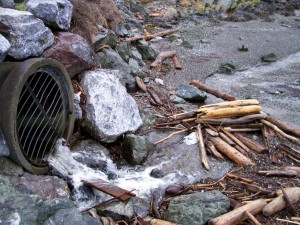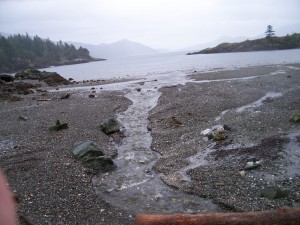By Mindy Kayl
When a rain drop falls in Eastsound it will most likely end up going into a storm drain like the one to the left. As the rain drop rolls over paved parking and roads, it will pick up and carry with it: particles of dust, drops of radiator fluid, pieces of break pads and tires, as well as oil from car engines.
Have you ever noticed a rainbow sheen on top of a puddle? That rainbow is usually caused by a thin layer of engine oil, a substance that can be damaging once it enters the shoreline ecosystem.
Depending on where a rain drop enters the system of pipes and settling ponds, it will roll down hill until it ultimately exits the system on the beach. The photo on the right is of the Eastsound Outfall pipe and below it is a photo of the stream of storm water leaving our paved town and flowing out into Eastsound.
The area where fresh water combines with salt water is called a mixing zone. These mixing zones are important habitats, they tend to be rich in nutrients and support a broad variety of marine life.
According to the Indian Island Marine Health Observatory Field Guide; at least 11 species of small fish, 7 crab species, 8 types of starfish, one species of Shrimp, a Burrowing Sea Cucumber, and the Purple Encrusting Sponge, as well as, Horse Clams, Steamer Clams, and Nuttall’s Cockle use this habitat. Some species are found here through out the year while others only use this habitat for part of their life like breeding and hatching then move on to different ocean habitats.
Some storm drains in town are now routed into the newly constructed storm water treatment ponds, located behind the Village Green. The water that goes through this system is hopefully a little ‘cleaner’ when it enters the outfall pipe, and ultimately flows in to Fishing Bay, past Indian Island then into the Salish Sea and Pacific Ocean.
**If you are reading theOrcasonian for free, thank your fellow islanders. If you would like to support theOrcasonian CLICK HERE to set your modestly-priced, voluntary subscription. Otherwise, no worries; we’re happy to share with you.**









